Structural Bamboo
Learning Objectives:
- Describe how bamboo grows and explain how this relates to its structural properties.
- Compare its carbon-sequestration capacity to that of other construction materials.
- Describe its resistance to earthquakes and fires.
- Discuss bamboo’s incorporation into projects, both in its natural state and as an engineered structural product.
Credits:
This course is approved as a Structured Course
This course can be self-reported to the AANB, as per their CE Guidelines
Approved for structured learning
Approved for Core Learning
This course can be self-reported to the NLAA
Course may qualify for Learning Hours with NWTAA
Course eligible for OAA Learning Hours
This course is approved as a core course
This course can be self-reported for Learning Units to the Architectural Institute of British Columbia
View course on architecturalrecord.com »
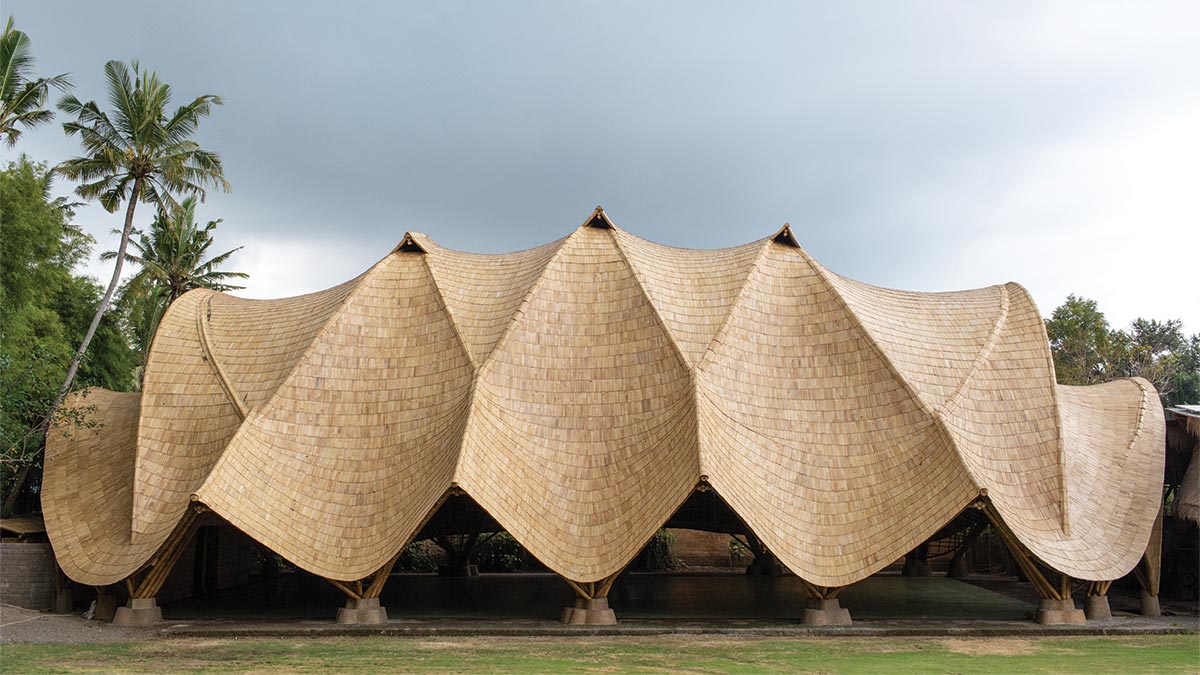
PHOTOGRAPHY: © TOMMASO RIVA
The Arc, the gym at the Green School in Bali, has a roof of anticlastic gridshells, 118 feet long and 45 feet high.
By now, the oft-repeated stats should be familiar: the built environment contributes nearly 40 percent of the greenhouse gases emitted annually, and at least one-quarter of that is embodied carbon, or the emissions associated with the manufacture of products used to make buildings and with the construction process. So how can we continue to build while minimizing these impacts? One answer is to use bio-based materials. And one such material—with untapped potential—is bamboo. It is abundant, has a rapid growth cycle, and is strong, sometimes characterized as vegetable steel.
What exactly is bamboo? Bamboo is often thought of as wood, but the plants are not trees. Instead, they are part of the grass family. More than 1,600 species exist, with most tending to thrive in humid climates close to the equator. These are divided into herbaceous types, which are slender-stalked and grow as understories, and the larger-diameter “woody” varieties more suitable for construction. Some have “running” root systems, which can send up new shoots as far as 100 feet from an existing culm (or stem), while others clump, growing new culms close to the base of an existing one.
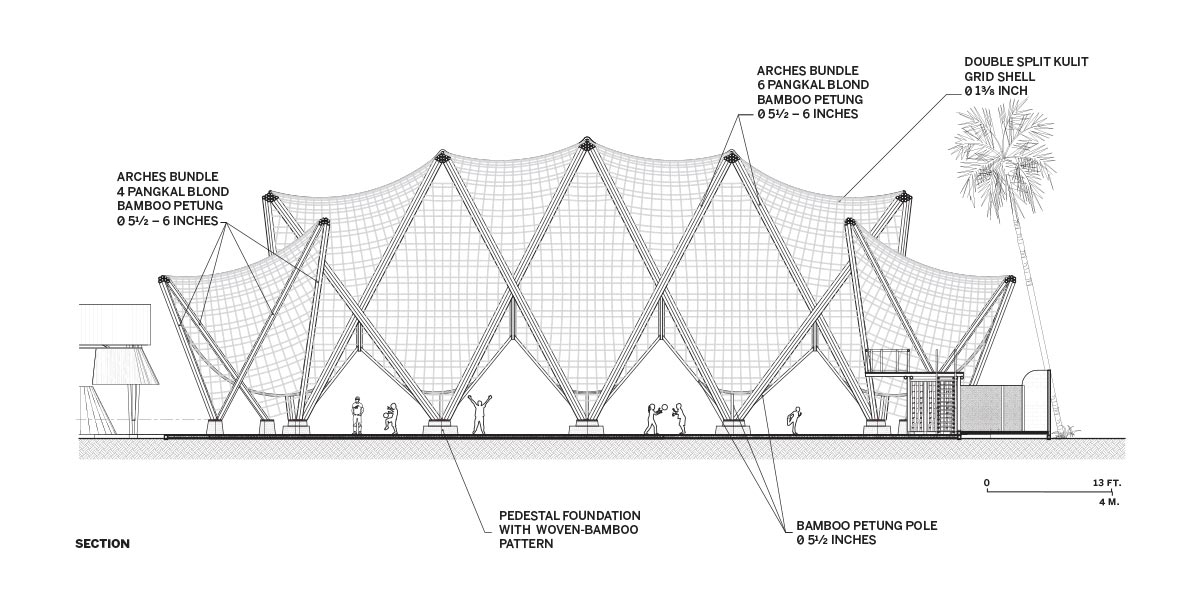
IMAGE: © IBUKU
Crisscrossing bamboo splits (above) running between arches of bundled bamboo (below) make up the Arc’s doubly curved gridshells.
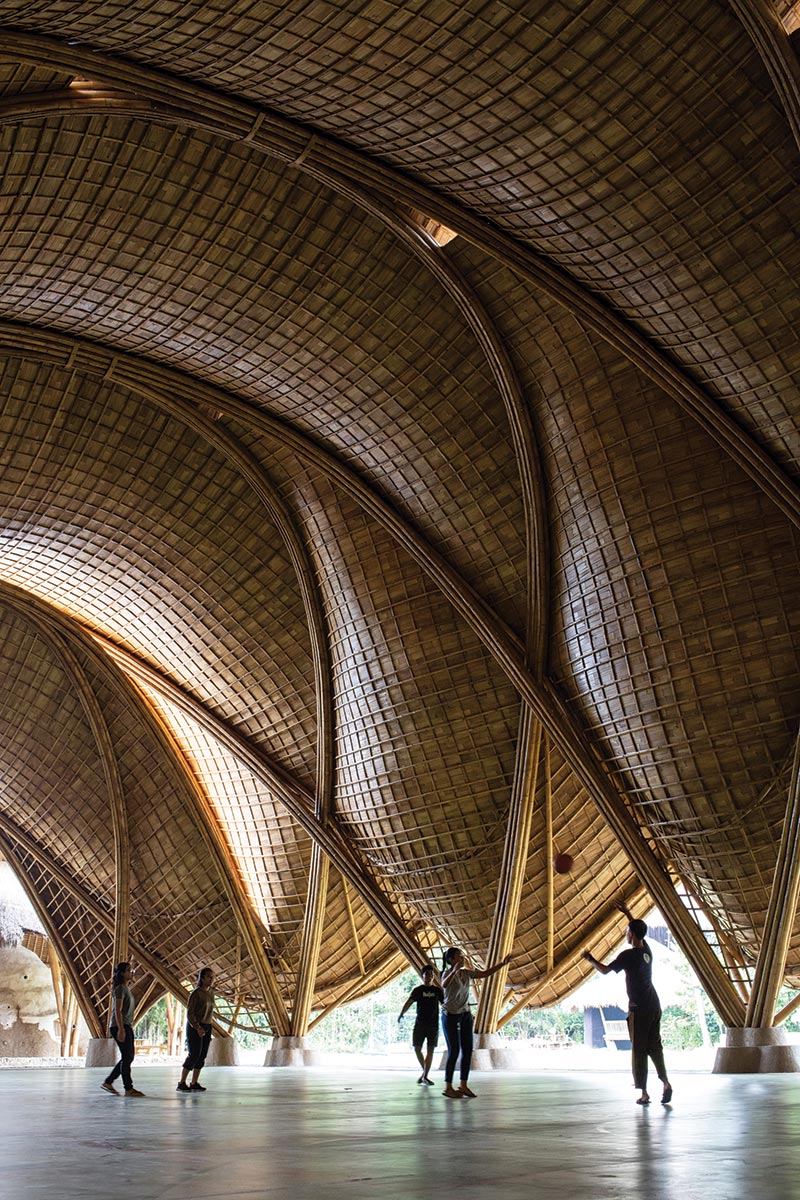
PHOTOGRAPHY: © TOMMASO RIVA
Bamboo is made up of nodes that segment the culm and act as diaphragms, preventing the otherwise hollow plant from buckling. In between run vascular bundles and cellulose fibers, providing bamboo with excellent performance along its axis in compression, bending, and especially tension. “If I imagined an ideal structural material, it would be bamboo,” says Neil Thomas, founder and director of the London-based engineering firm Atelier One.
Of course, bamboo has been used as a construction material for thousands of years. But one reason it is attracting more attention now is its ability to store carbon. According to the International Bamboo and Rattan Organization (INBAR)—an intergovernmental group that promotes development using those two materials—bamboo ecosystems contain between 94 and 392 metric tons of carbon per hectare (tC/ha), depending on species, soil conditions, geography, and other factors. Although this is markedly less than the carbon captured by natural forests, which contain between 126 and 699 tC/ha, it is comparable to that of tree plantations. In addition, points out INBAR, unlike most tree species, many types of bamboo can be grown on degraded land, helping satisfy the dual goals of soil restoration and carbon sequestration.
From a climate-solution standpoint, bamboo’s most remarkable attribute is its quick maturation and regeneration cycle. Bamboo can be harvested within three to seven years of sprouting, with the same clump producing multiple harvests. (According to some estimates, a single bamboo clump can produce up to nine miles of usable culm over a 15-year period.) This growth pace means, that compared to most tree species, bamboo plants generally have higher yields and higher storage of carbon when they are used to make buildings or long–life span products. Over a 30-year period, the carbon-storage potential of durable products made from guadua, a South American bamboo species, is 134.7 tC/ha, compared to only 30.0 for Chinese fir, says INBAR.
The material does have its limitations, however, especially when used in its natural state. Without proper precautions, bamboo is susceptible to moisture, insect infestation, UV degradation, and—because the culms are hollow—they pose a high fire risk. And, though bamboo buildings are often cited for their ability to survive earthquakes because of their flexibility, this is a bit of a misconception, says Sebastian Kaminski, an associate structural engineer in the London office of Arup. Bamboo buildings have historically performed well in quakes primarily because bamboo has a high strength-to-weight ratio, which generally results in lightweight buildings, and seismic loads are proportional to mass, he explains.
For the last 14 years, Kaminski has been working to address bamboo’s shortcomings, and enhance the durability and livability of bamboo buildings, offering them as a solution for affordable and disaster-relief housing across the global south. Among his bamboo-related projects is an INBAR design guide, created with collaborators from academia and practice. It outlines a structural system that builds upon the wattle-and-daub construction methods still used in much of the developing world, incorporating modern materials and techniques.
The improved version of the vernacular, known as a composite bamboo shear wall (CBSW), or engineered bahareque—as the traditional system is called in some regions of Latin America—is well-suited for one- and two-story structures in rural settings or in city outskirts, says Kaminski. The assembly sits on reinforced-concrete foundations supporting a masonry upstand, to elevate the bamboo frame above the ground. A matrix of cane or small-diameter bamboo, or bamboo lath, is nailed to one or both sides of the frame, and then galvanized-wire mesh is affixed as reinforcement. The final layer is a coating of cement mortar. By adding such details as generous roof overhangs to protect against the driving rain, use of bamboo treated with the chemical element boron to guard against insect infestation, a minimum thickness of the mortar for fire protection, and proper seismic connections, a CBSW building can be robust and last for as long as 50 years, says Kaminski. And, notably, the embodied carbon of a structure relying on such a system is less than half of one using more conventional manufactured materials, like concrete masonry, that are typical in humanitarian housing. “That is even before taking into account the biogenic carbon,” he says, referring to the carbon stored within the bamboo. Thus far, the CBSW has been sanctioned by the building codes of Colombia, Ecuador, and Peru, as well the International Organization for Standardization (ISO). Efforts are also under way to incorporate it into the Philippine, Mexican, and Nepalese building standards.
In Indonesia, bamboo is part of the culture, notes Defit Wijaya, lead architect at Bali-based design firm IBUKU. But now the studio, which focuses almost entirely on bamboo, is creating a new formal vocabulary for the ages-old material. One emblematic project is the Arc, a gymnasium at the Bali campus of the Green School, a pre-K through 12th-grade independent school. The product of a collaboration with Colombia-based bamboo specialist Jörg Stamm and Atelier One, the 8,000-square-foot building has no walls, in keeping with the school’s nature-focused mission. But it is sheltered under a striking sculptural roof, 118 feet long and 45 feet tall at its highest point, that seems to recall some extinct armored mammal. The structure, made primarily of the bamboo species Dendrocalamus asper, or Bambu Petung, is supported by a series of interlocking arches, each a bundle of culms rising from concrete pedestals and spanning 65 feet. Between them, crisscrossing bamboo splits form doubly curved gridshells topped with a waterproofing membrane. The whole is topped with a layer of plupuh, or shingles of flattened bamboo.
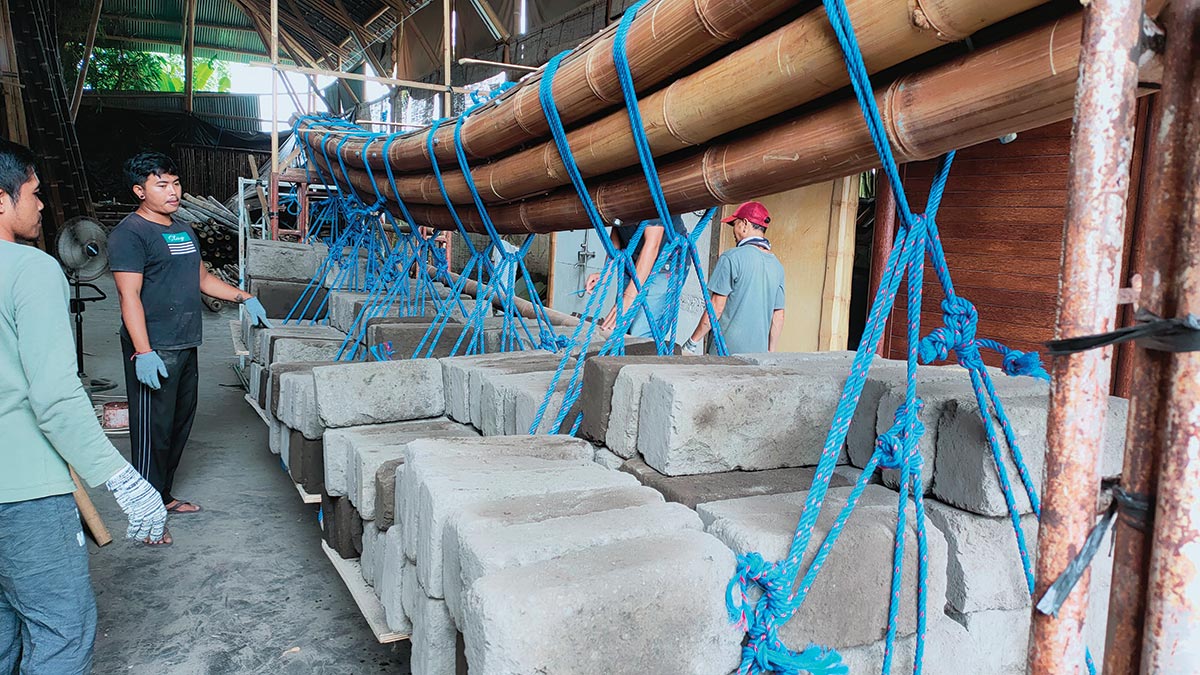
PHOTOGRAPHY: © JAME WOLFF, PT BAMBOO
Full-scale physical tests (above) helped designers understand the loading capacity of the Arc’s structural elements. The Arc’s bamboo arches rise from concrete pedestals (below).
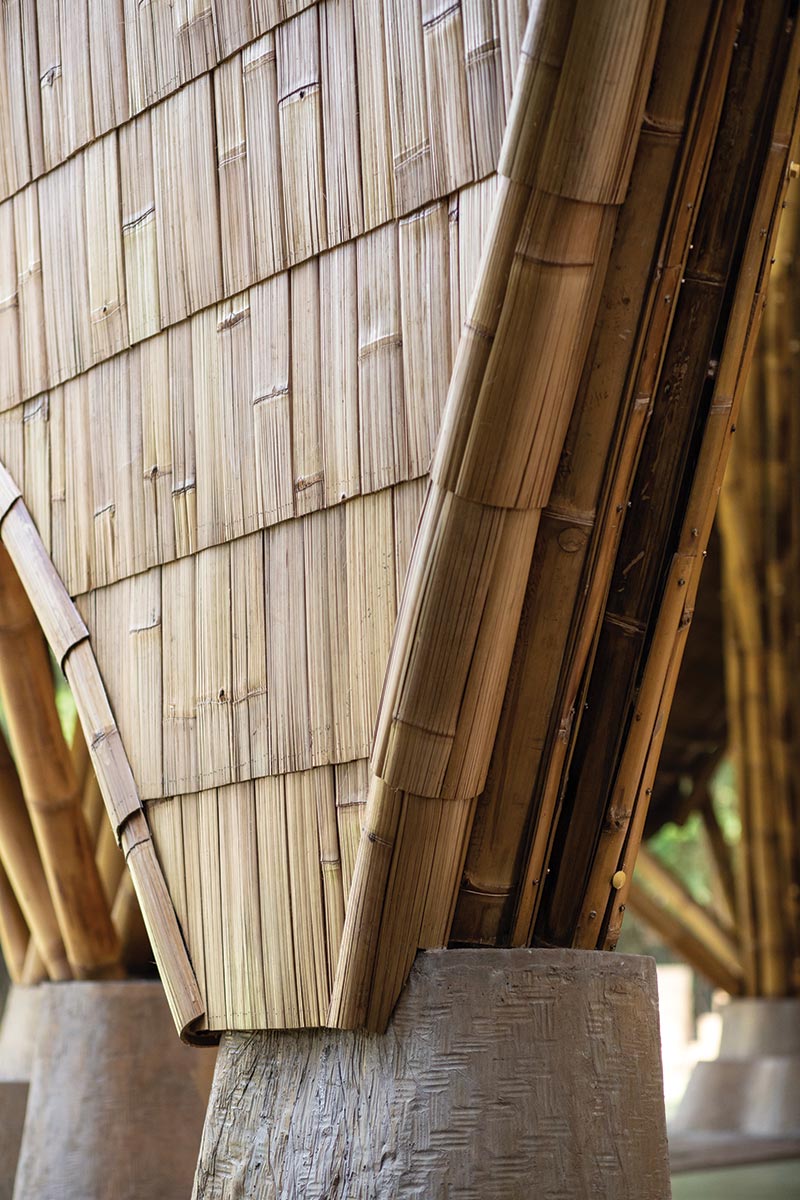
PHOTOGRAPHY: © TOMMASO RIVA
















